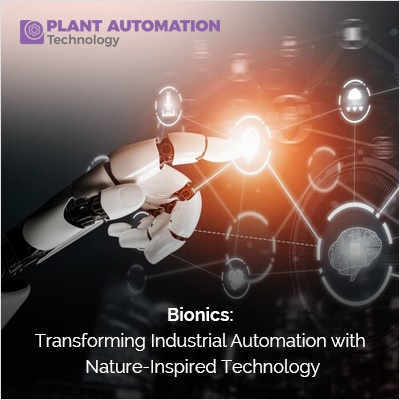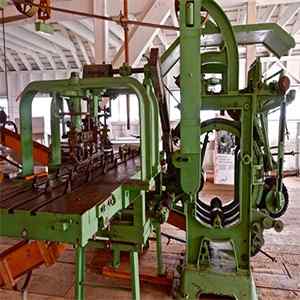Bionics: Transforming Industrial Automation with Nature-Inspired Technology

In an era of rapid technological advancements, the field of industrial automation is experiencing a revolutionary transformation with the emergence of bionics. Nature-inspired technology is providing a fresh perspective on how we approach automation in industries ranging from manufacturing to agriculture. By drawing inspiration from the ingenious designs found in nature, bionics aims to replicate the efficiency and adaptability of natural systems.
How bionics is transforming industrial automation?
Bionics is revolutionizing the field of industrial automation by merging the principles of biology and engineering. By studying the complex and efficient mechanisms in nature, scientists and engineers are developing innovative solutions that enhance automation processes. From mimicking the movements of animals to replicating the structure of plants, bionics is unlocking new possibilities in industrial automation.
One remarkable example of bionics in industrial automation is the development of robotic arms that imitate the dexterity and strength of an elephant's trunk. By studying and replicating the intricate muscle and tendon structure of the trunk, engineers have created robotic arms capable of performing delicate tasks with precision and flexibility. These advancements have revolutionized industries such as manufacturing, where tasks that were once performed by human workers can now be executed by robotic systems.
Bionics is also transforming the transportation industry with the development of drones inspired by the flight patterns of birds. By studying the aerodynamics and wing structures of birds, engineers have created drones that can navigate complex environments, collect data, and perform tasks that were previously impossible. These bird-inspired drones are finding applications in various industries, including agriculture, where they are used for crop monitoring, pesticide spraying, and even pollination.
Bionics is not limited to mimicking individual organisms; it also draws inspiration from the collective intelligence and efficiency of social insects. Ant colonies, for example, are known for their remarkable ability to organize and optimize their tasks. Researchers have developed algorithms based on the behavior of ant colonies, which are used to optimize complex industrial processes such as logistics, supply chain management, and routing.
Nature-inspired technology in industrial automation
Nature has evolved over millions of years to create efficient and sustainable systems. By studying these systems, engineers can unlock valuable insights and apply them to industrial automation. One area where nature-inspired technology is making a significant impact is in the development of materials and structures.
The lotus leaf, for example, has inspired the creation of self-cleaning surfaces. The unique microstructure of the leaf repels water and prevents dirt and contaminants from sticking. By replicating this structure, scientists have developed self-cleaning coatings that can be applied to industrial equipment, reducing maintenance costs and improving efficiency.
Another example is the creation of biomimetic materials that mimic the strength and flexibility of spider silk. Spider silk is known for its exceptional strength-to-weight ratio, making it an ideal material for applications such as bulletproof vests and medical implants. By understanding the molecular structure of spider silk, scientists are developing synthetic materials with similar properties, opening up new possibilities in industries such as aerospace and healthcare.
Advantages of using bionics in industrial automation
The integration of bionics in industrial automation offers numerous advantages that can significantly improve efficiency, productivity, and sustainability. One of the key advantages is the ability to replicate the adaptability and resilience found in natural systems.
Natural systems have evolved to adapt to changing environments and optimize their performance. By emulating these adaptive capabilities, bionics enables industrial automation systems to respond effectively to dynamic conditions. For example, robots equipped with bionic-inspired sensors can adjust their movements and behavior based on real-time data, improving their performance and safety in unpredictable environments.
Bionics also offers the potential to reduce energy consumption and waste in industrial processes. By studying the energy-efficient designs found in nature, engineers can develop systems that optimize energy usage and minimize waste. For instance, wind turbine blades inspired by the shape of bird wings can increase energy capture and reduce noise pollution.
Furthermore, bionics can enhance safety in industrial settings. By replicating the sensory capabilities of animals, such as the ability to detect heat or vibrations, industrial automation systems can identify potential hazards and react accordingly. This can significantly reduce the risk of accidents and injuries in industrial environments.
Case studies of successful bionic applications in industrial automation
The transformative power of bionics in industrial automation is evident in numerous case studies where nature-inspired technology has revolutionized industrial processes. One such example is the field of robotics, where bionics has enabled the development of robots capable of performing tasks with precision and adaptability.
In the manufacturing industry, bionic-inspired robots have been used to improve assembly line processes. By studying the movements of animals such as insects and reptiles, engineers have developed robots capable of complex and precise movements. These robots can handle delicate components, perform intricate tasks, and adapt to changes in the production line, resulting in improved efficiency and productivity.
In agriculture, bionics has led to the development of robotic systems that can automate tasks such as harvesting and crop monitoring. For example, robots inspired by the structure and movements of spiders can navigate through crops, identify ripe fruits, and harvest them without damaging the plants. This not only improves efficiency but also reduces the reliance on manual labor and minimizes crop damage.
Challenges and limitations of bionics in industrial automation
While bionics holds great promise for transforming industrial automation, it is not without its challenges and limitations. One of the main challenges is the complexity of replicating the intricate designs and mechanisms found in nature. Nature has evolved over millions of years, optimizing its systems through trial and error. Replicating these systems in a controlled and efficient manner is a significant engineering challenge.
Another challenge is the integration of bionic systems with existing industrial processes and infrastructure. Retrofitting existing systems to incorporate bionic-inspired technology can be complex and costly. Additionally, there may be resistance to change and a lack of understanding of the potential benefits of bionics in some industries.
Furthermore, ethical considerations must be taken into account when developing and implementing bionic systems. For example, the use of animal-inspired technology raises questions about animal welfare and the ethical treatment of living organisms. Striking a balance between technological advancement and ethical responsibility is essential in the development and implementation of bionic systems.
Prospects of bionics in industrial automation
Despite the challenges, bionics holds immense potential for the future of industrial automation. As technology continues to advance, engineers and scientists are pushing the boundaries of what is possible with bionics. The integration of bionics is expected to play a crucial role in addressing the pressing challenges faced by industries, such as sustainability, efficiency, and safety.
In the coming years, we can expect to see further advancements in bionics, with more industries adopting nature-inspired technology. The development of advanced sensors, materials, and algorithms will enable the creation of even more efficient and adaptable bionic systems. This will lead to increased productivity, reduced environmental impact, and improved safety in industrial processes.
Industries benefiting from bionics in industrial automation
Bionics has the potential to revolutionize a wide range of industries, each benefiting from the unique advantages offered by nature-inspired technology. Manufacturing is one of the primary industries benefiting from bionics, with the development of robots capable of performing complex tasks with precision and flexibility.
The transportation industry is also experiencing significant advancements through bionics. From drones mimicking the flight patterns of birds to autonomous vehicles inspired by the navigational abilities of insects, bionics is transforming the way we move goods and people.
Agriculture is another industry that stands to benefit greatly from bionics. By automating tasks such as planting, monitoring, and harvesting, bionic systems can improve efficiency, reduce labor costs, and optimize crop yields. Furthermore, the development of sustainable and efficient irrigation systems inspired by plant structures can contribute to water conservation in agriculture.
Implementing bionics in industrial automation: Best practices and considerations
When implementing bionics in industrial automation, certain best practices and considerations should be taken into account. Firstly, it is essential to have a clear understanding of the specific challenges and requirements of the industry or process being automated. This will help identify the most suitable nature-inspired technologies and ensure seamless integration.
Collaboration between engineers, scientists, and industry experts is crucial to the successful implementation of bionics. By bringing together diverse expertise and perspectives, innovative solutions can be developed that address the unique needs of each industry.
Furthermore, it is important to continuously evaluate and optimize bionic systems. Monitoring performance, collecting data, and making adjustments based on real-time feedback will enable continuous improvement and ensure the long-term success of bionic implementations.
Conclusion: The future of bionics in industrial automation
The fusion of nature and technology is paving the way for a more efficient and environmentally conscious era of industrial automation. Bionics, with its nature-inspired technology, is transforming industrial processes, offering improved efficiency, reduced energy consumption, and increased productivity.
While challenges and limitations exist, the potential benefits of bionics in industrial automation are undeniable. Through the development of innovative solutions, the integration of bionics is reshaping industries, enhancing safety, and creating new opportunities for sustainable development.
As technology continues to advance, bionics will play an increasingly vital role in addressing the challenges faced by industries. By drawing inspiration from nature's efficiency, adaptability, and sustainability, bionics is set to revolutionize the way we approach industrial automation, creating a future where nature and technology converge to optimize processes and improve our world.






